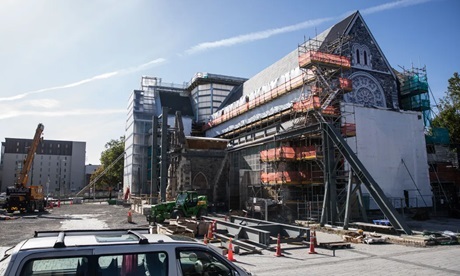Economists say the Christ Church Cathedral rebuild should go ahead.
In a report for Christ Church Cathedral Reinstatement Ltd (CCRL), economists from the NZ Institute of Economic Research (NZIER) say despite escalating costs, it’s worth finishing the $240 million project.
The Government should help close the funding gap, their report says.
After analysing the pros and cons, the economists say “the benefits of reinstatement outweigh the costs, indicating that the project should proceed”.
Urgent and ongoing funding
Deconstruction over the past year has uncovered the size of the problem CCRL is facing.
“We are dealing with a 150-year-old earthquake-damaged building. There are insufficient as-built plans from the 1880s and planning has included many assumptions which are now just being revealed to us” says CCRL chairperson Mark Stewart.
The estimated price tag escalated from $100 million in 2016 to $160 million last year.
CCRL needs at least $30 million and a “new funding pathway” by August. It says otherwise the project will be mothballed, leaving the cathedral as is.
Cost-benefits
The economists’ report calculates the net benefit of a restored cathedral at between $1 million and $30 million.
This is largely due to Christ Church Cathedral’s intangible “social, cultural and economic value for all New Zealanders”.
The NZIER economists calculated it is likely to gather around $20 million a year from tourism. That makes for a cost-benefit ratio of 1.1 to a strong 3.0.
The Cathedral is a “public good”. This puts the onus on the Government to “play a role in closing the funding gap” the economists wrote.
The gap is reportedly at least $114 million. It could be more, since to keep it this low requires $42 million from other sources. That additional money includes extra funding from the Anglican Church.
“As many of the benefits are associated with public goods or positive externalities, there is a case for central and local government to contribute toward the costs of reinstatement alongside the Anglican Church, tourism operators and philanthropists” the report says.
Public sentiment is divided. Some say “stop now”. Others say “it must be finished”.
Investment opportunity
The report aimed to help the Government, City Council and potential funders to decide whether to invest more.
While the cathedral’s market value from direct use – eg tourism – was tiny, its reinstatement is needed to unlock the full value of investments in surrounding streets.
The economists estimated that value at a billion so far and another billion by 2034.
The economists say they did not analyse keeping the cathedral as a partially restored ruin. Nor did they quantify the disadvantages either from a public eye-sore point-of-view or from public safety issues.
The greatest benefits arose from the cathedral’s non-use value of $9-$30 million. That “mainly consists of the value people gain from knowing the Cathedral has been reinstated, even if they do not visit it” the report says.
This is based on international stated cultural site preference surveys, keyed to Category 1 historic place.
Boost for residents
The 2011 earthquake destroyed many Christchurch heritage sites. This makes the remaining few “especially important to Christchurch residents” the report says.
Restoring it will also “strengthen social cohesion and contribute to New Zealand’s earthquake engineering capability”.
Source
Additional readingNews category: New Zealand.




